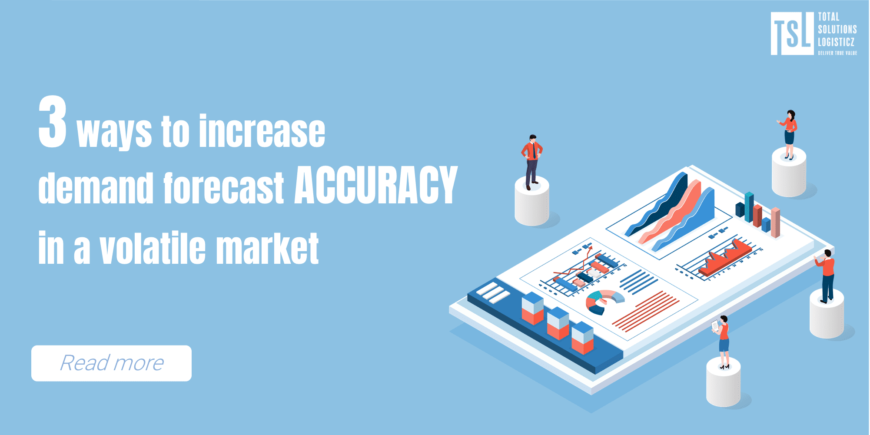Three ways to increase demand forecast accuracy in a volatile market
As new headlines constantly remind us, the world’s supply chains are operating in an increasingly precarious business landscape. The high costs and uncertainty of raw materials, components, labor and transportation have led to some significant product shortages ― most visibly, semiconductor chips impacting the automotive industry, but other products as well…
When products are scarce, it becomes even more critical to create an accurate demand forecast, so you can match supply and demand in a way that optimizes both profitability and service levels. Sending your limited supply of products to the wrong place in today’s world can be disastrous, as you have stock-outs and lost sales in most markets, but pockets of excess inventory sitting around eroding your margins somewhere else.
Legacy planning systems and spreadsheet-based, manual demand planning processes used by many of the world’s manufacturers and retailers haven’t caused today’s product shortages and other supply chain issues — but they’re only exacerbating the situation.
In a typical organization, multiple functional teams develop their own siloed forecasts, leading to a lack of alignment and consensus across the organization. In addition, every team runs its own forward-looking scenarios, importing data from different sources and, thus, arriving at different conclusions. Because manual processes and data silos are prone to error and not all data has been vetted for accuracy, there are plenty of forecasting mistakes along the way. The result? Stocks-outs, overstocks, lost sales, eroded margins and missed revenue targets.
When both supply and demand were more predictable, these manual, time- and labor-intensive processes might have produced results that were “good enough” to roughly match products with customers. But, in today’s world of massive upstream and downstream volatility, new modern solutions and best planning practices are required for companies to survive, let alone thrive. Demand forecasters and planners need to do better.
Three ways to increase demand forecast accuracy in a volatile market
While there’s no simple answer to precisely matching scarce products with customers in today’s environment of extreme uncertainty, Blue Yonder offers three best practices in demand forecasting that can drive a significant improvement in accuracy.
1. Collect direct customer insights
What are your customers looking for? Maybe you should start by asking them. B2B companies can often access supplier portals and data interchanges that include a detailed projection of future customer demand.
B2C companies can gather a range of data about consumers’ needs and behaviors on a localized basis — and it goes without saying that, in today’s fast-changing landscape, this data should be gathered as near to real-time as possible. These direct customer insights provide a strong foundation for a single demand forecast that will be shared among all stakeholders.
2. Leverage third-party data
Demand may be unpredictable, but there are nearly always signals of upcoming demand changes. Your data stream should include inputs from customers, but also reflect market trends, competitor insights, social media, events, weather and news.
Because this third-party data is going to be both structured and unstructured, it’s critical to have the right tools and processes in place to capture it, store it and begin the task of interpretation. This third-party data, gathered in real-time, can be combined with direct customer sales projections to create a shared data repository that’s the basis for the forecast.
3. Apply artificial intelligence/machine learning
Without a doubt, this is the most important best practice ― and the one where most forecasting organizations fall short today. The current generation of demand analytics engines, supported by artificial intelligence/machine learning (AI/ML), offer truly incredible capabilities for scanning enormous volumes of data, applying proprietary algorithms, identifying patterns, sensing deviations and arriving at an extremely accurate, localized demand forecast.
Today’s advanced analytics not only produce a single forecast that’s reliable enough to share across the business, but they create a dynamic forecast that’s rapidly, seamlessly and autonomously updated in near real-time. As market conditions inevitably shift, the forecast evolves to reflect the current reality — enabling manufacturers and retailers to quickly pivot and re-align supply with demand.
The Blue Yonder Difference
Blue Yonder’s demand planning solution is purpose-built for this task. AI-enabled optimization engines ingest huge volumes of real-time data from different sources, apply intelligent algorithms and sophisticated segmentation strategies, run scenarios autonomously and create highly accurate forecasts. The forecast is updated easily as conditions change, even multiple times per day, without the need to wait for manual processes and consensus-building meetings. Thanks to ML capabilities, the forecasting engine learns from real-world results to become more and more accurate all the time.
Extend your added value, take your forecast accuracy to the next level with Luminate Request Edge, an extensible and enhanced SaaS solution. This solution works by leveraging machine learning to develop accurate demand forecasts and can incorporate hundreds of real-time demand signals for many business benefits.
Unfortunately, both demand and supply volatility seem to be here to stay — at least for the foreseeable future. But, by relying on AI/ML and best practices, your forecasting team can pivot with both intelligence and agility as conditions shift. In today’s challenging environment, the winners will be those companies that act with speed to adopt new forecasting solutions and processes that help transform uncertainty from a hurdle into a competitive advantage.
Blue Yonder is not only a supply chain solution provider, but also a vision-sharing partner with businesses to help them make positive changes in the future. From predicting customer needs, Blue Yonder helps companies reduce costs, increase profits, and improve collaboration to follow customers’ promises anytime, anywhere.











